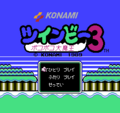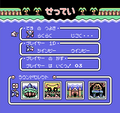
| TwinBee 3: Poko Poko Dai Maou | |
|---|---|
| Developer(s) | Konami |
| Publisher(s) | Konami |
| Year released | 1989 |
| System(s) | Famicom |
| Preceded by | Moero TwinBee |
| Followed by | TwinBee Da!! |
| Series | TwinBee |
| Genre(s) | Shooter |
|---|---|
| Modes | Single player, Multiplayer |
TwinBee 3: Poko Poko Dai Maou (ツインビー3 ポコポコ大魔王TwinBee 3: Poko Poko Dai Maou? lit. TwinBee 3: Great Demon King Poko Poko) is a vertical-scrolling shoot 'em up produced by Konami originally released for the Famicom in 1989. It was the third game in the TwinBee series released for the Famicom, following the home version of the original TwinBee and the Famicom-exclusive Moero TwinBee. Unlike Moero, which was released in North America as Stinger, TwinBee 3 was a Japan-only release.
GwinBee, the third ship, is kidnapped by the eponymous Poko Poko while on an errand. It's up to TwinBee and WinBee to defeat the demon lord and rescue their friend. The player can shoot and collect bells, earning different bonuses for whatever color it happens to be, and can use both air-to-air guns and air-to-ground bombs to defeat enemies and find power-ups. As the ships take damage, they first lose their bomb-throwing arms and eventually explode, though the player can catch flashing icons to repair the damage.
TwinBee 3 ditches the side-scrolling stages from Stinger and only features top-scrolling ones similar to the original. Moreover, the game lacks the 3-Player mode from Moero, allowing only up to two players to play simultaneously. The game is considerably easier than its predecessors due to an option mode that allows players to adjust the difficulty and number of ships, as well as the inclusion of the new "soul reviving system", which allows players to recover their power-ups after losing a ship.
The game uses digitized PCM voice samples, particularly when the conga music in one stage chants "Poko Poko", and in the beginning of each stage, in which a voice proclaims the name of the stage. It was re-released on April 14, 2006 as part of the i-Revo downloadable game service.
-
Title screen
-
Optioncs screen


